Wallpaper for the kitchen: a variety of types, design options and tips for choosing

Wallpaper is one of the most popular types of wall cladding. They are used in all areas of the home, including the kitchen. From the material of our article, you will learn what the varieties of this material are and what requirements are imposed on them. We will dwell on the fashion trends of this cladding in detail and outline the main nuances of the choice, taking into account the style and color solutions of the interior.






Primary requirements
Usually, when choosing wallpaper for decorating a particular room in a dwelling, an ordinary buyer pays attention to the pattern, design and texture. However, in doing so, he forgets to take into account other criteria that are of no less importance. For example, they have their own requirements for the facing material selected for the kitchen, namely:
- the cladding must be practical, otherwise repairs in the kitchen will have to be done often;
- panels should not be thin with a loose structure, since they will absorb moisture, grease and foreign odors;
- the material should not unnecessarily attract dust, since in the process of frequent maintenance it will wear out faster;
- wallpaper should not be afraid of moisture, fumes, temperature drops and dampness;
- panels should be easy to care for, of high quality and made from modern raw materials;
- materials should correspond to the requests of a particular style, indicating that they belong to a certain direction of interior design;
- the cladding should be selected taking into account the visual improvement and zoning of the available space;
- the texture of the material is selected taking into account the high indicators of strength and wear resistance;
- if possible, the composition of the material should be fire-resistant, which complies with fire safety standards;
- materials must be resistant to fading and accidental mechanical damage (touch).






The rest of the requirements are not so important, but they make it possible to simplify the work of cladding.
- Wallpaper selected for kitchen wall cladding should have a slightly elastic structure, which is especially good when adjusting them when glued to not entirely flat walls.
- Materials are selected based on the convenience of work, therefore, preference should be given to options of greater width. When working with them, less trimming and joining is obtained, which reduces the time for facing.
- The density of the products matters: the priority is gluing without overlap, which is visually noticeable, especially with thicker sheets. Too thin material requires more preparation of the walls, since it highlights all their imperfections.
- If possible, you need to take products that provide for wet cleaning, including using detergents. As a last resort, if the wallpaper is not washable, then they should provide for dry cleaning.
- Wallpaper should correspond to the status of the interior and the degree of illumination of a particular kitchen.
If possible, they should be subject to correction or painting, which will extend their service life.



Species overview
Specialists in the field of interior design pay attention to the undesirability of using simple and thin wallpaper in the kitchen, paper, jute, bamboo and liquid. None of these types of cladding are suitable for gluing in the kitchen due to their impracticality. However, from the widest range of options produced by trademarks, several can be distinguished. All of them are roll-type products, provide for a different type of docking, differ in the type of texture. Let's outline their main nuances.


Vinyl
Compared to other varieties, vinyl wallpaper has a key advantage: inertness to moisture and air. They can be different, they look expensive and noble, which is why they can raise the status of even a laconic interior. They are resistant to ultraviolet radiation, are easy to stick and perfectly mask the unevenness of the walls, do not grow moldy and are not susceptible to the formation of fungus. However, if such wallpaper is glued in the kitchen, it will have to be ventilated more often.
Vinyl wallpaper can have a paper or non-woven backing. They can be foamed, embossed, dense, made by hot stamping or silk-screen printing. The texture of this facing material varies, it can be glued to plasterboard, wooden, concrete bases, plaster and chipboard. This material is practical, wet and dry cleanable, durable and aesthetically pleasing.


Textural
Such wallpaper for the kitchen is called in another way compact vinyl, they are one of the modifications of vinyl coverings, differ in their ability to imitate different materials, including stone, brick, plaster, textiles. You can glue them on an unprepared and rough base, they are durable, they are not afraid of wet cleaning, they are not scratched. They feature a wide range of colors and designs. They are very expensive, do not fade under the sun.
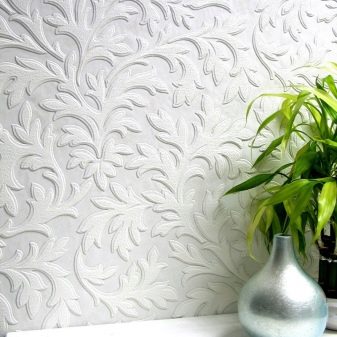

Non-woven
These wallpapers are notable for the fact that when glued they are able to stretch slightly under tension without tearing. Like vinyl varieties, in the process of gluing non-woven wallpaper does not form bubbles, which is typical for paper counterparts of budget cost. In fact, it is a material with a breathable structure, which is created from compressed cellulose fibers. Unlike other varieties, they can be painted.
This category includes 2 types of wallpaper: completely non-woven and with a non-woven base. Outwardly, they resemble paper ones, however, in tactile sensations they are similar to textiles.Fully non-woven fabrics are multi-layered, their layers - with the exception of the top embossed one - are even and smooth. These wallpapers can be painted, they are stronger and more durable.
The second counterparts can have 3 types of tops: vinyl, paper and textile, these wallpapers are cheaper.


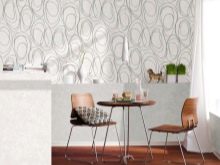
Glass fiber
These facing materials are distinguished by high fire resistance rates. They are durable, practical, and are characterized by high strength. They are made from quartz sand, clay and limestone, which allows achieving high performance characteristics. Such coatings do not crack or tear during service. It is a woven material that is created on looms.
Outwardly, such coatings resemble paper, in contrast to fiberglass, they can be painted no more than 20-25 times. This wallpaper is used as a covering with a decorative function. They are several times denser than fiberglass; if repainting is necessary, they do not need any surface preparation. The material is expensive, it is chosen when the wallpaper is not going to be changed for at least 10 years.
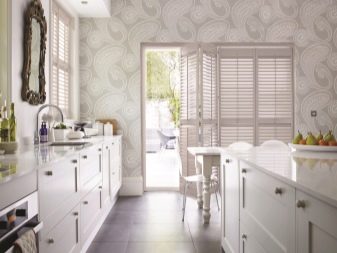

Fiberglass
This material is mistakenly called synonymous with fiberglass, although in reality they are 2 different types of claddings. Fiberglass has high quality and strength characteristics, it is an order of magnitude better than vinyl wallpaper, fire resistant and durable. The material is non-woven, it is made by pressing fiberglass threads, the texture of such wallpaper is smooth, outwardly similar to paper.
Due to the technological peculiarities of production, the fiberglass cannot have a relief or a pattern. You can paint the glass cloth canvases as many times as you want. In this case, the material can be further used as a substrate for decorative plaster.
The basis of the material does not stand out under the paint, and the coloring of such canvases is almost always of high quality and uniform. However, these canvases must be primed before painting.

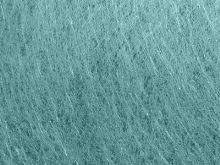

Acrylic
This wallpaper is somewhat similar to vinyl, however, their surface substance is applied to the paper backing by a point technique, leaving microscopic pores for air ventilation. Foamed acrylic is applied to the paper base, forming an airy embossed print on the surface. These panels weigh less than their polyvinyl counterparts, they are easy to stick, moisture resistant, however, short-lived.
The advantage of such wallpapers is harmlessness: during operation, they do not emit toxins into the air, but unlike vinyl counterparts, these wallpapers are not so moisture resistant.


Impregnated paper
Coatings of this type are used to decorate the background of the interior, despite the fact that they are not washable and can only be dry cleaned. Unlike other types of wallpaper material, they are not as durable and practical. They are glued for no more than 3-5 years, choosing options on which contamination will not be too noticeable. This cladding has a lot of disadvantages: it fades faster than other coatings in its segment.
Besides, it becomes covered with fat spots if there is a dining group near it... However, if the panels are bought to decorate the guest corner of the kitchen-living room, it is quite appropriate to consider them as a worthy option for decorating wall ceilings. In this case, it is worth starting from the base, selecting coatings that mask the irregularities and roughness of the wall.


Plastic
Such wallpapers are made of polyvinyl chloride polymer material. A layer of porous plastic is located in a polymer cushion, due to which the coatings are both durable and breathable. The wallpaper is multi-layered, while the number of layers can vary, which is reflected in their weight: they are light and heavy. They can be painted, washed with a damp cloth or sponge. Someone refers these wallpapers to vinyl varieties. They have the ability to insulate wall ceilings, allow air to pass through well, and are distinguished by their durability.


Wallpaper
Canvases with photo printing are today considered one of the most effective tools for creating the necessary mood in the kitchen. They can be very diverse: traditional, stereoscopic, in the form of a small panel, a paired symmetrical pattern to accentuate the space. On sale you can find products in the form of an accent on a part of the wall, a panoramic image with a perspective defined by an optical illusion. These canvases are especially popular with interior design professionals.
These coverings, depending on their size, can visually enlarge the space. They are made not only from paper, but also from more practical raw materials, due to which they acquire resistance to sunlight and moisture resistance. They are traditional and anti-vandal. Variants of the second type have a special layer of protection, which makes them resistant to accidental mechanical damage.

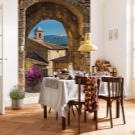




Color spectrum
The color scheme of the facing material for the background design of the walls can be very diverse. Wallpaper can be light, bright, monochromatic, patterned, in soft bleached colors or dynamic. The choice of this or that option will depend on various factors. For example, the side of the wall where the windows face is of no small importance.
If they face south, it is preferable to acquire cool colors, as warm colors will create a stifling atmosphere in the kitchen. If the windows face north, it is necessary to balance the color with warm, but not hot tones. It should be borne in mind that in such a room it can be a little dark, and the colors can be somewhat distorted.
Also, when choosing the color of the wallpaper, it is important to take into account the footage of the room: the smaller it is, the lighter and simpler the canvas.






Conventionally, all colors can be fit into several groups: light or pastel, natural, neutral, bright and dark. The neutral range consists of white, gray, black tones. Such wallpapers look stylish in the interior, however, white is not suitable for kitchens: it is too easily soiled. Even the slightest dirt is visible on such wallpaper. Light gray, on the contrary, fits well into the interior composition, if supplemented with furniture and elements of arrangement of live colors.
The black color on the canvases should be strictly metered, otherwise the kitchen runs the risk of becoming uncomfortable. However, as a slight contrast to support any elements of furniture (for example, fittings or the color of the hob of the stove), black in the wallpaper print is quite appropriate. White can also be part of the wallpaper pattern, it visually ennobles the space and softens its perception.

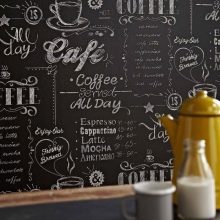
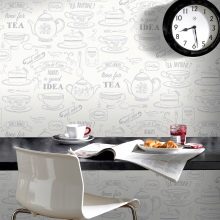
Pastel tones of roll wallpaper are by far the best color group. They are able to bring freshness and lightness into the interior, visually increase the width and height of the walls. In addition, such colors leave the opportunity to accentuate any functional area of the kitchen by using bright elements (for example, through kitchen skins, a tiled apron, spectacular photo wallpapers with a bright pattern). The best paints in this group are whitewashed turquoise, light mint, pale pink and blue, as well as ivory and light pistachio. In addition, the group includes caramel, light peach and pearl tones.
The natural group includes beige, milky, creamy colors, shades of wood, including light wenge, cocoa tone. In addition, these are brownish paints. In order not to turn the kitchen into a kind of wooden bath, you need to choose the right colors for the wallpaper. For example, it can be paired canvases or so-called companions, consisting of light (for the main background) and bright (to accentuate a part of the wall or a structural ledge, niche). Vivid colors can also be part of a pattern on a light or even white background.



For those who prefer a dynamic design, trade marks offer to pay attention to wallpaper in bright colors. This is the choice for spacious rooms where it is necessary to perform functional zoning of space. At the same time, as a rule, bright wallpapers are complemented by light ones to soften the background design of the kitchen. Green, fuchsia, yellow, turquoise, orange, rich pistachio are in fashion.
However, the use of tones must be dosed, because their task is to create a background, and not interrupt attention and rivalry with every piece of furniture. The same rule applies to dark colors: in a minimal amount, they give expressiveness to the drawing, when there are many of them, they become an incomprehensible interior spot, breaking the harmony of color design.
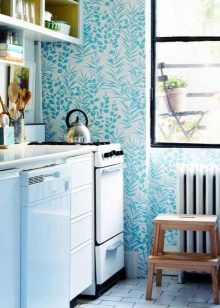


Prints
Today, the choice of colors of wallpaper material allows you to satisfy the most demanding customer requests. At the same time, today they are tuned to a different style of interior, which greatly simplifies the selection of the right option. For example, these can be canvases:
- with a landscape, plates, meadow flowers or in a cage, a strip for country styles and French Provence;
- with a bamboo pattern or cherry blossoms and fanzas to embody the atmosphere of oriental style;
- with monograms to create an atmosphere of a classic style or any of its varieties;
- brickwork, stone, rough plaster or concrete for loft or grunge styles;
- aged or painted wood for vintage interior style trends;
- with conventional or 3D printing of the type of a metropolis for modern styles (modern, hi-tech).

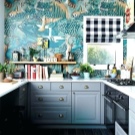




Floral and plant prints are in fashion. However, if earlier it was rustic wallpaper with flowers or overly bright roses, then the modern look at wallpaper design is more aesthetic. This is a beautiful and interesting print with daisies, poppies, dandelions, lavender, orchids. In addition, colors with birds and fruits (lemons, oranges, grapes, apples) are relevant.
Also popular are textured prints (for example, geometric and striped reliefs).



Design options and fashion trends
The modern design of wallpaper for the kitchen can be very diverse. They can:
- be smooth without relief, resembling fabric or paper;
- monochromatic with a relief pattern and a rough surface;
- with a fibrous coating, pores, granular and blistered;
- a pattern shimmering in the light in the color of the main background;
- metallized, coated with flexible paint;
- embossed, with the possibility of forming prints or matte.
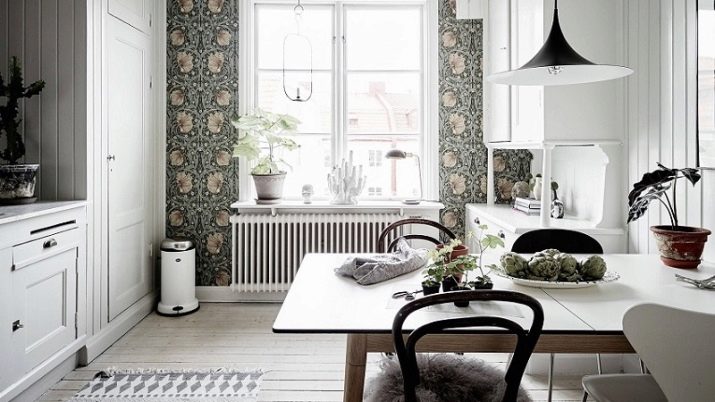


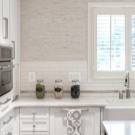


Popular types of kitchen finishes are plaster and fiberglass paintable cladding due to their durability. In addition, photowall-paper is in trend, the images on which are applied through high-quality printing. If matting was fashionable last season, today large plants (for example, dill umbrellas) are in priority in the form of a certain composition.
With the help of such wallpaper, you can accentuate any of the functional areas of the kitchen.


Combination options
Today, more and more often, to create the versatility of the interior, they resort to the method of combining wallpaper. With the help of it, expressiveness and high status can be brought into the interior. For example, you can bet on the contrast of monochromatic canvases with printed companions. Let's say you can designate it with stylish accent wallpaper:
- a dining area in the form of a part of a wall or a panel;
- the wall above the headset, if the apron is without a pattern;
- constructive protrusions or kitchen niches;
- partitions separating different functional areas;
- the wall at the head of the sofa or the entire wall in this area;
- the lower part of the bay window wall, in which the recreation area is located;
- the partition formed when the kitchen is connected to the loggia.

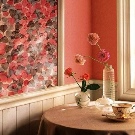
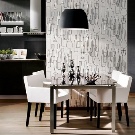



We take into account the color of the headset
Kitchen wallpaper should be selected taking into account the color of the existing furniture, in particular, the headset. Based on this, you can:
- to pick up related tones of the pattern of panels with facades;
- choose a color that will match the color of the headset;
- focus on the identical tone of the fittings (handles, finishes).
If the color of the headset is light, the accent wallpaper can be vibrant. At the same time, it is not at all necessary to buy, for example, bright red panels for a white headset. It is enough to choose white with elements of the pattern in red. The beige set will look beautiful against the background of gray canvases with a geometric pattern. It can also be distinguished by means of wallpaper with photo printing in lilac tones.

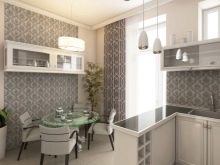

Wallpaper with a light background and a brownish pattern is suitable for dark brown. For example, it could be an urban print depicting unique architecture. The unity of color will not seem boring if the furniture of the dining group is, say, pistachio. For a neutral headset, you can choose a version of wallpaper in the same neutral colors, adding the desired mood, for example, using red, beige, green.
However, whatever color was taken as a basis, the colors of the wallpaper, headset and interior accessories should be in harmony with each other. Ideally, there should be no more than four of them.
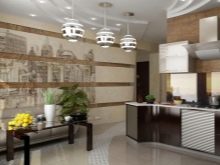


Features of choice
When buying wallpaper for the kitchen, you must pay attention to several nuances.
- If the room is dark, you need to take light wallpaper that expands and increases the space.
- No need to take striped wallpaper for the walls of small kitchens: they do not work for the good of the interior.
- It is undesirable to take wallpaper in the color of curtains or kitchen textiles: against such a background, the wallpaper will be lost, as will the status of the room.
- It is better to select one-meter-wide canvases: when gluing them, there are fewer joints, this simplifies the work.
- If possible, it is better to take paired wallpaper: you do not have to match colors with artificial distorting light in the store.
- The print should match the temperature and style of the room - do not take something that does not fit the interior at all.
- Don't put classics in a tiny kitchen: the monograms on the walls look really bad here.
- You cannot glue wallpapers of different styles in the kitchen - this breaks the interior and makes the room uncomfortable.
- When choosing a color, one should not forget about its perception: for example, pink is not suitable for men, purple is boring, black and blue is depression.
- You cannot combine cheap wallpapers with expensive ones, because of this expensive canvases lose their status.






Beautiful examples
We bring to your attention 10 interesting ideas for choosing kitchen wallpaper, which can be taken as a basis when selecting material for cladding kitchen walls in an apartment or a private house:
- accenting the wall of a classic kitchen;

- original emphasis with a claim to high status;

- textured light wallpaper for Provence style;

- a non-standard example of decorating a kitchen with brick wallpaper;

- playing with complex perspectives with colorful wallpaper;

- geometry on the walls of the corner, equipped for the dining group;

- abstraction to match the facades of the kitchen set;

- an unusual combination of neutral plant cladding with a brick apron;

- decorative wallpaper expanding the space in the dining area;

- bringing the mood of the desired era into the space of the dining area.

How to choose the right wallpaper for the kitchen, see the next video.








